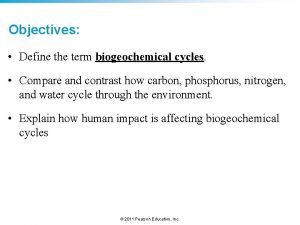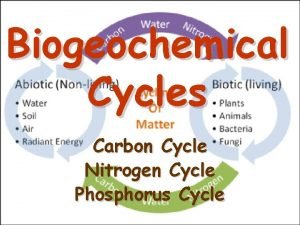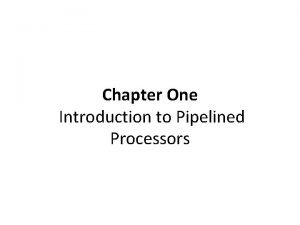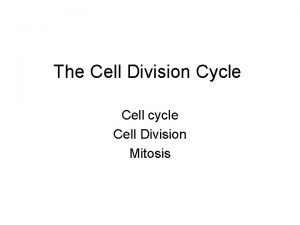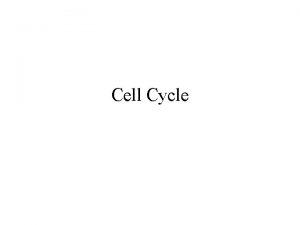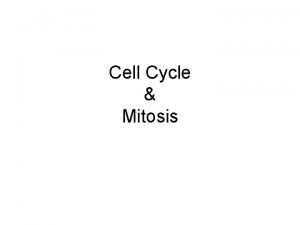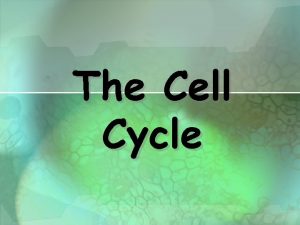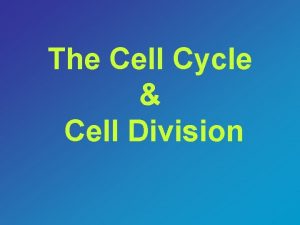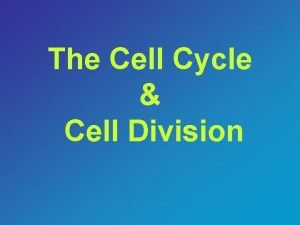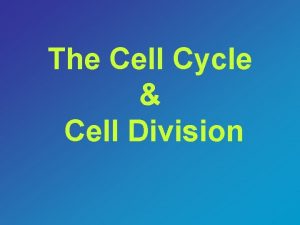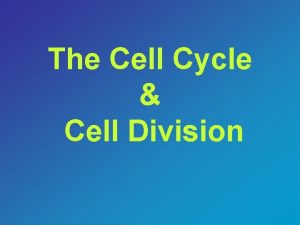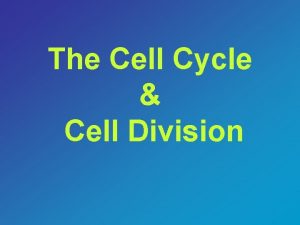Cell Division Cell Cycle What is cell division













- Slides: 13

Cell Division & Cell Cycle

What is cell division?

Cell Division - cell division is a process by which a cell, called the parent cell, divides into two/four cells, called daughter cells. - in mitotic division, the daughter cells can become parent cells and go into subsequence division. - in meiotic division, the daughter cells will be permanently transformed and cannot divide again.

Why cell division?

Cell Division - for unicellular organisms such as the Amoeba, one cell division reproduces an entire organism. - cell division can create progeny from multicellular organisms, such as plants that grow from cuttings. - cell division also enables sexually reproducing organisms to develop from the one-celled zygote, which itself was produced by cell division from gametes. - cell division allows for continual renewal and repair of the organism.

Cell Cycle - cell cycle is the series of events that take place in a eukaryotic cell leading to its duplication through cell division. - certain fly embryos sport cell cycles that last only 8 minutes per cycle. - some mammals take much longer than that up to a year in certain liver cells. - for fast-dividing mammalian cells, the length of the cycle is approximately 24 hours.

Cell Cycle - the cell cycle consists of four distinct phases: G 1 phase, S phase, G 2 phase (collectively known as interphase) and M phase. - cells that have temporarily or reversibly stopped dividing are said to have entered a state of quiescence called G 0 phase. What types of cell permanently in G 0 phase?

G 0 Phase - nonproliferative cells in multicellular eukaryotes generally enter the quiescent G 0 state from G 1 and may remain quiescent for long periods of time, possibly indefinitely (as is often the case for neurons). - this is very common for cells that are fully differentiated. - some cell types in mature organisms, such as parenchymal cells of the liver and kidney, enter the G 0 phase semi-permanently and can only be induced to begin dividing again under very specific circumstances.

G 1 Phase - the first phase within interphase, from the end of the previous M phase till the beginning of DNA synthesis is called G 1. - during this phase the biosynthetic activities of the cell, which had been considerably slowed down during M phase, resume at a high rate. - this phase is marked by synthesis of various enzymes that are required in S phase, mainly those needed for DNA replication. - duration of G 1 is highly variable, even among different cells of the same species.

S Phase - S phase starts when DNA synthesis commences; when it is complete, all of the chromosomes have been replicated, i. e. each chromosome has two (sister) chromatids. - during this phase, the amount of DNA in the cell has effectively doubled, though the ploidy of the cell remains the same. - rates of RNA transcription and protein synthesis are very low during this phase. - an exception to this is histone production, most of which occurs during the S phase. - the duration of S phase is relatively constant among cells of the same species.

G 2 Phase - cell undergoes a period of rapid growth to prepare for mitosis. - significant protein synthesis occurs during this phase, mainly involving the production of microtubules, which are required during the process of mitosis. - inhibition of protein synthesis during G 2 phase prevents the cell from undergoing mitosis.

Regulation of Cell Cycle - Regulation of the cell cycle involves steps crucial to the cell, including detecting and repairing genetic damage, and provision of various checks to prevent uncontrolled cell division. - The molecular events that control the cell cycle are ordered and directional; that is, each process occurs in a sequential fashion and it is impossible to "reverse" the cycle. - Two key classes of regulatory molecules, cyclins and cyclin-dependent kinases (CDKs), determine a cell's progress through the cell cycle.

Cell Cycle Checkpoints - cell cycle checkpoints are used by the cell to monitor and regulate the progress of the cell cycle. - If a cell fails to meet the requirements of a phase it will not be allowed to proceed to the next phase until the requirements have been met. - several checkpoints are designed to ensure that damaged or incomplete DNA is not passed on to daughter cells. - two main checkpoints exist: the G 1/S checkpoint and the G 2/M checkpoint. -G 1/S transition is also known as restriction point. Lack of growth factors causes some cells to arrest at the restriction point. If a cell is not ready, or external conditions are not appropriate for the S phase, then the cell may enter G 0 phase.
 Cell cycle and cell division
Cell cycle and cell division Cell cycle and cell division
Cell cycle and cell division Cell division phases
Cell division phases Biology.arizona.edu/cell bio/activities/cell cycle/01.html
Biology.arizona.edu/cell bio/activities/cell cycle/01.html Long division and short division
Long division and short division What is the missing number in the synthetic-division array
What is the missing number in the synthetic-division array Short and long division
Short and long division Divide using long division
Divide using long division Where can you find groundwater brainpop
Where can you find groundwater brainpop Difference between phosphorus cycle and carbon cycle
Difference between phosphorus cycle and carbon cycle Difference between phosphorus cycle and carbon cycle
Difference between phosphorus cycle and carbon cycle Difference between open cycle and closed cycle gas turbine
Difference between open cycle and closed cycle gas turbine Reservation table in computer architecture
Reservation table in computer architecture Chapter 5 principles of engine operation
Chapter 5 principles of engine operation









